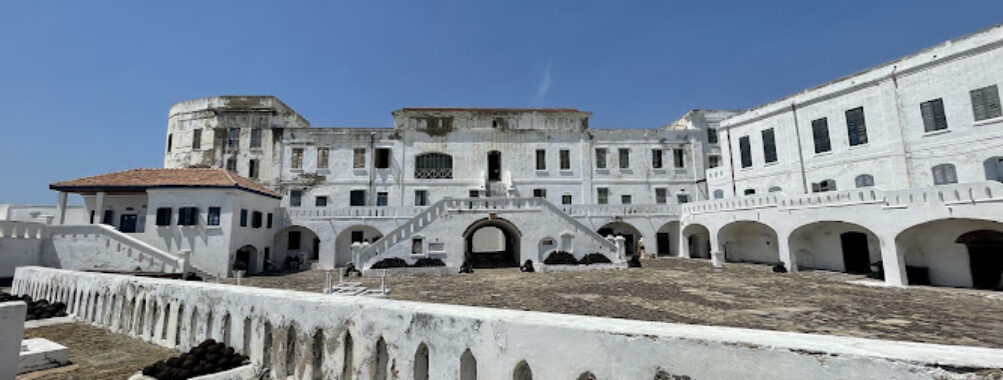
Cape Coast Castle
“`html
Table of Contents
Description
Cape Coast Castle is one of those places that sticks with you long after you’ve left. Perched right on the shoreline of Ghana’s Cape Coast, this imposing whitewashed fortress carries centuries of history within its thick stone walls. Originally built by Europeans in the 17th century, it became one of the major hubs of the trans-Atlantic slave trade. Today, it stands not only as a historical landmark but also as a museum and a place of remembrance. Walking through its corridors, you’ll feel the contrast between the breezy ocean views above and the dark, suffocating dungeons below. It’s sobering, emotional, and strangely beautiful all at once.
Visitors often describe the experience as powerful and moving, but also heavy. And that makes sense—this isn’t just another tourist attraction. It’s a place where countless lives were changed forever. Yet, despite the weight of its past, the castle has become a site of education and reflection, attracting people from all over the world who want to understand history more deeply. It’s well-preserved, accessible, and thoughtfully curated, though some areas can feel crowded during peak times. Overall, it’s the kind of place that leaves you thinking, and maybe even a little changed, after your visit.
Key Features
- Guided tours led by knowledgeable local guides who bring history to life with stories and context.
- The haunting slave dungeons, which give a visceral sense of the conditions endured by captives.
- Dalzel Tower, offering sweeping views of the ocean and coastline.
- Old cannons and defensive walls that reflect the castle’s military role.
- The West African Historical Museum, showcasing cultural artifacts, ceremonial drums, muskets, and shackles.
- Waterfront location, with dramatic waves crashing against the fortress walls.
- Wheelchair accessible entrance and parking, making it more inclusive for all visitors.
- Family-friendly environment where children can learn about history in a respectful way.
Best Time to Visit
If you’re planning a trip, timing can make a big difference. The dry season, from November to March, is generally the most comfortable time to visit. The skies are clearer, the air less humid, and you can enjoy the coastal views without worrying about sudden downpours. That said, the castle is open year-round, and even during the rainy season, the experience indoors is just as impactful. Personally, I’d recommend going earlier in the day to avoid the midday heat and the larger tour groups that tend to arrive later. Morning visits often feel quieter and more contemplative, which suits the atmosphere of the site.
And if you’re someone who enjoys cultural events, keep an eye on local festivals in Cape Coast. Pairing a castle visit with a community celebration can give you a richer sense of the area’s heritage and resilience.
How to Get There
Cape Coast Castle is located right in the heart of Cape Coast city, which makes it fairly easy to reach. From Accra, Ghana’s capital, it’s about a three-hour drive along the coastal highway. The road is paved and relatively straightforward, though traffic can be unpredictable—so give yourself extra time. If you don’t want to drive, there are buses and shared taxis that run regularly between Accra and Cape Coast. Once in the city, the castle is a central landmark, so you won’t have trouble finding it.
For those who prefer a more relaxed journey, hiring a private driver or joining a guided day tour from Accra can take the stress out of navigating. Plus, having someone local handle logistics means you can just soak in the scenery—rolling hills, small fishing villages, and glimpses of the Atlantic along the way.
Tips for Visiting
Visiting Cape Coast Castle isn’t like ticking off a fun bucket-list item—it’s more of an emotional journey. Here are a few things worth keeping in mind:
- Take the guided tour: The guides are excellent storytellers, and their insights will give you a much deeper understanding than wandering on your own.
- Wear comfortable shoes: The floors are uneven, and you’ll be walking through dungeons, staircases, and open courtyards.
- Be prepared emotionally: Some parts of the tour are heavy, and it’s normal to feel overwhelmed. Give yourself space to process.
- Photography: Cameras are usually allowed, but be mindful and respectful—it’s not a place for flashy selfies.
- Plan for at least 2 hours: Between the tour, the museum, and just sitting quietly to take it all in, you’ll want unhurried time.
- Hydrate and dress for the weather: It can get hot and humid, especially in the afternoons.
- Consider combining with nearby attractions: The Kakum National Park canopy walk or Elmina Castle can make for a full, unforgettable day of exploring history and nature.
One last thought: don’t rush through it. Take a moment to stand by the ocean-facing walls, watch the waves, and imagine the ships that once anchored offshore. It’s a hauntingly beautiful reminder of how far we’ve come and how important it is to remember.
“`
Location
Places to Stay Near Cape Coast Castle
Find and Book a Tour
Explore More Travel Guides
No reviews found! Be the first to review!